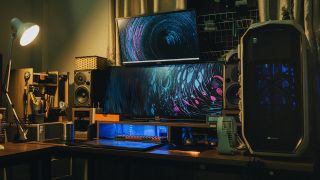Like any electronic device, your home computer (opens in new tab) is going to use more energy the harder you make it work. This is true of desktop PCs, laptops (opens in new tab), tablets (opens in new tab) and smartphones (opens in new tab). While it’s switched off, it uses no electricity, so for the truly power-conscious this is the ideal state for it to be in. This, however, can be problematic from a productivity point of view. Unless you’re using it to block the door open on a hot day, you’ll want to actually use your PC, so if you’re looking for lower power bills, there are a few more things to consider.
So how much power does your PC use?
PCs today are much more energy efficient than they were even ten years ago. Every time the microchip manufacturing industry shrinks its lithography process - the method through which the electronic pathways of a processor are etched onto a silicon wafer before being turned into a working part of your computer, the product needs less energy to do its job. As chip lithography is currently measured in nanometres, modern chips are ridiculously complicated, with the Intel i7 9700K launched at the end of 2018 cramming almost three billion transistors into its 174mm2 die on a 14nm process, and consuming 1.4 volts. Compare this with the Intel 80486 from 1989: it managed to fit 1.2 million transistors into about the same area using its 1000nm process. And it needed five whole volts to make it work. The i7 is also orders of magnitude more capable than the 486, but the processor isn’t the only thing you have to consider. GPUs are particular power hogs, with Nvidia’s latest requiring two power feeds from the Power Supply Unit (PSU) to work. Every component in your PC consumes power, all supplied by the PSU, which takes your mains AC supply and turns it into something the components can use. Each PSU has a rating, measured in Watts, of how much power it can supply. This is a maximum figure, and doesn’t mean that it’s running at that level all the time. In fact, canny PC builders allow an overhead in their power calculations (or guesses) so that their PSU never reaches its maximum output. This is because, as they reach the top of their capabilities, their efficiency drops and they start producing a lot of heat. Keep them running at about 75% of maximum, and they’ll run cooler, more efficiently, and hopefully last longer. This is of no help if you’ve got a laptop, as the PSU is the charger you’re supplied with and it all goes through the moderating interface of the battery anyway. If what you’re looking for is a long battery life, then recent improvements in both lithium cells and processor architectures have done much to help. Switching to ARM processors, more commonly found in tablets and cellphones, from Intel and AMD’s chips seems to help a lot, as Apple has shown with its latest Apple Silicon M1-based laptops. If you’re really interested in how much juice your PC pulls from the mains, you can pick up a plug-in electricity usage meter for around $20 (opens in new tab). These plug into your wall socket, and measure how much electricity is being used through it, so make sure to make sure your PC, monitor(s), and any peripherals with separate power supplies are all plugged into the same power strip going into the same socket, so you get a complete picture. And while you can watch the figure on the meter’s screen go up when you start loading your computer’s processors, perhaps by playing a demanding 3D game or transcoding some video files, you will also see the difference between letting it go to sleep and turning it off completely. Modern PCs are extremely good at lowering their power usage when asleep, and can be set to go to sleep quickly when they realize they’re not being used, but they do use some - enough to keep the data in its RAM alive. RAM chips are ‘volatile’, which means they need a constant flow of electricity, otherwise they lose the data stored in them.
Can you save energy?
An alternative to sleep is hibernation, which dumps the contents of your RAM to non-volatile storage such as a hard drive or (preferably) an SSD, and turns the PC off, restoring it to its previous state when you turn it back on. It’s not as instant a resume as from sleep, as the PC needs to go through the full boot process, but it uses less energy. The question of PC energy consumption is a complex one, but the simplest answer is that, if you have a case filled with power-hungry components and drive them hard, then you are going to use more energy than if you use a svelte ARM laptop just for web browsing. The amount you pay for electricity depends on where you live, with places like Hawaii much more expensive than New York, so the only person who can answer the next question is you: are your power bills too high? For more advice on computing, we have a guide to the most common reasons Windows 10 is slow on your PC (opens in new tab), and a look at the best antivirus software (opens in new tab).
